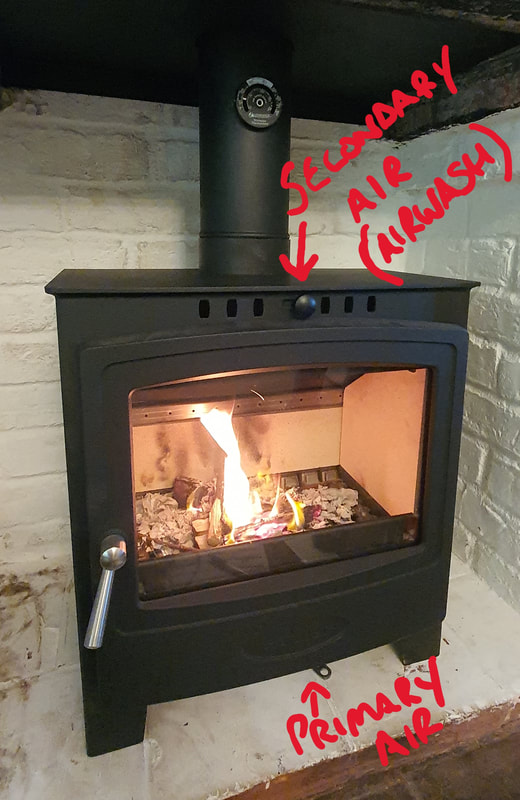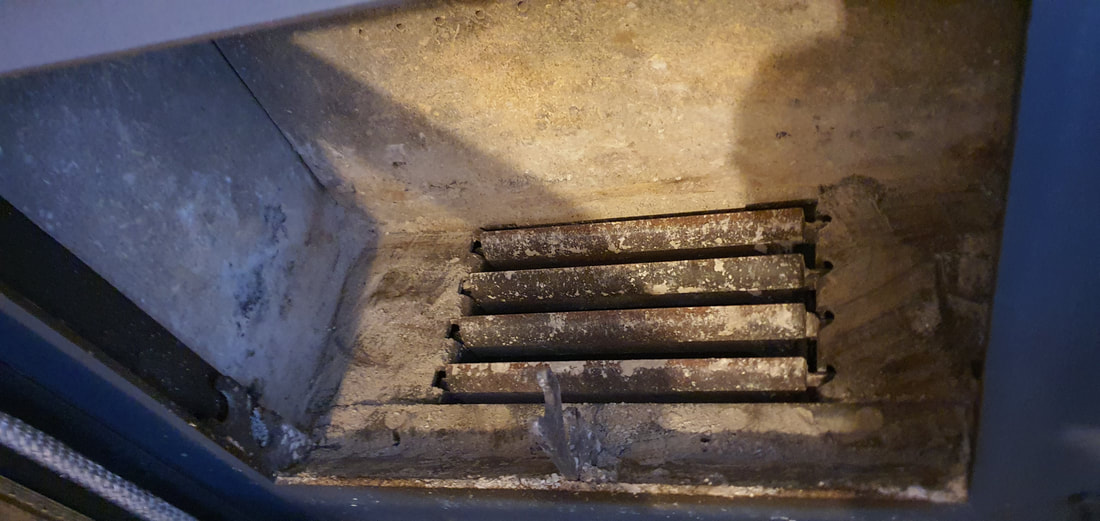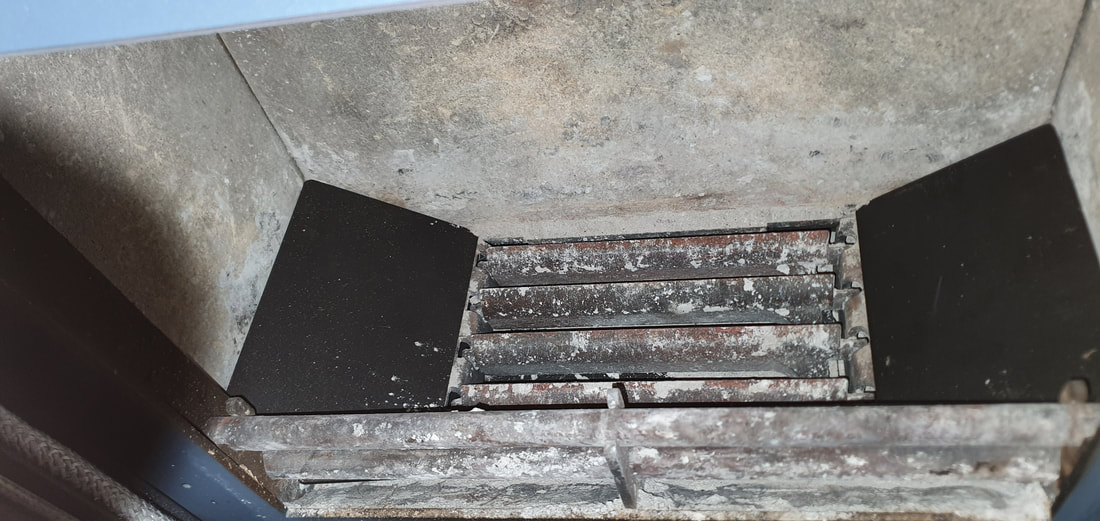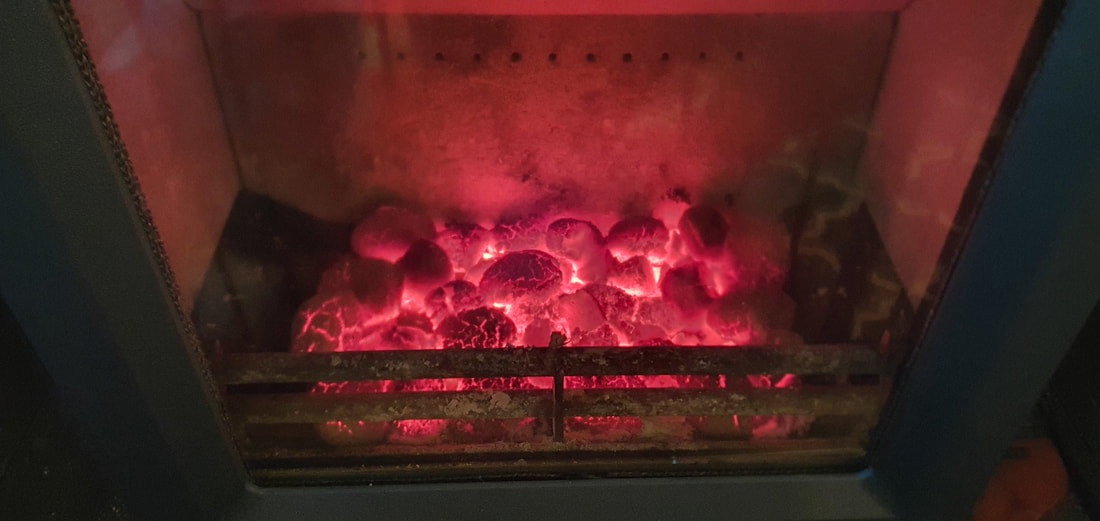A multifuel stove is a popular choice because it gives you the versatility of a variety of fuels, but many homeowners are unaware how to use the controls of a multifuel correctly.
A typical multifuel stove has two or sometimes 3 air controls but usually a primary air control (lower part of the door) and a secondary (upper part of the door or stove body)
On advanced stoves there may just be two dials or levers, you will need to consult your manual to find out which control is which.
The primary air control is used for solid fuel as solid fuel requires air from underneath the grate to burn effectively, this is achieved with the grate in the open position ( if you have a mechanical grate) so the air can pass through to the fuel.
When burning solid fuel it is critical that the ash pan and grate are cleaned out after every use to ensure free air flow under the fuel and through the grate, as the fuel burns down you will need to riddle the ash build up so it falls into the ashpan below.
Wood however is the opposite, it uses the secondary or airwash, as wood needs air above the fuel to burn economically and the grate is kept in the closed position to allow the ash to build up above the grate, there is no need to riddle the grate when burning wood.
The 3rd air control is the tertiary, this comes through drill holes in the rear fire brick or a holed bar at the rear, this may not be adjustable on all models but this achieves a clean burn by adding extra air directly above and behind the fuel and is particularly effective when burning softer woods and burns off particulates.
Your multifuel stove could have a single air control for wood and solid fuel, so the only change you need to make is to ensure if you have a moving grate that it is in the open position for Solid fuel to allow the air to pass through, and closed for wood to stop the air from coming up underneath and burning through your wood to quickly.
The primary can be used to assist starting a wood fire but should not be used when the stove is burning well, this will only burn through your wood at a very quick rate and not very economically.
its always a good idea to read through your stove manual to make sure you are aware of the controls and what they are for.
if you don't have a manual for your stove they can easily be downloaded from the internet after a quick google search.
Type in the stove make and model followed by instruction manual.
A typical multifuel stove has two or sometimes 3 air controls but usually a primary air control (lower part of the door) and a secondary (upper part of the door or stove body)
On advanced stoves there may just be two dials or levers, you will need to consult your manual to find out which control is which.
The primary air control is used for solid fuel as solid fuel requires air from underneath the grate to burn effectively, this is achieved with the grate in the open position ( if you have a mechanical grate) so the air can pass through to the fuel.
When burning solid fuel it is critical that the ash pan and grate are cleaned out after every use to ensure free air flow under the fuel and through the grate, as the fuel burns down you will need to riddle the ash build up so it falls into the ashpan below.
Wood however is the opposite, it uses the secondary or airwash, as wood needs air above the fuel to burn economically and the grate is kept in the closed position to allow the ash to build up above the grate, there is no need to riddle the grate when burning wood.
The 3rd air control is the tertiary, this comes through drill holes in the rear fire brick or a holed bar at the rear, this may not be adjustable on all models but this achieves a clean burn by adding extra air directly above and behind the fuel and is particularly effective when burning softer woods and burns off particulates.
Your multifuel stove could have a single air control for wood and solid fuel, so the only change you need to make is to ensure if you have a moving grate that it is in the open position for Solid fuel to allow the air to pass through, and closed for wood to stop the air from coming up underneath and burning through your wood to quickly.
The primary can be used to assist starting a wood fire but should not be used when the stove is burning well, this will only burn through your wood at a very quick rate and not very economically.
its always a good idea to read through your stove manual to make sure you are aware of the controls and what they are for.
if you don't have a manual for your stove they can easily be downloaded from the internet after a quick google search.
Type in the stove make and model followed by instruction manual.
Below is some instructions on how to use a multifuel stove burning wood and then solid fuel types.
First picture below shows logs being burnt on this vey advanced Woodwarm Phoenix Firegem stove (note 2 levers at the base of the stove) primary air (left) is completely shut, secondary (right) slightly open for a slow and controlled burn rate.
First picture below shows logs being burnt on this vey advanced Woodwarm Phoenix Firegem stove (note 2 levers at the base of the stove) primary air (left) is completely shut, secondary (right) slightly open for a slow and controlled burn rate.

Below shows the primary and secondary ( airwash) air controls on this less advanced Hamlet Solution Widescreen
When only burning wood grate needs to be closed if mechanical, ash can be kept above the grate and the next fire built on top.
ash build up over the closed grate
Stove now cleaned out for solid fuel use, grate in the open position
Some stoves come with angled solid fuel cheeks which channel the fuel over the open grate for effective burning
Stove loaded ready for a solid fuel fire, primary air control fully open, secondary open slightly to keep glass clean
more solid fuel added on top of the well burning kindling, primary closed down 1/2 way
Solid fuel now burning well, primary air now only open a 1/3
Solid fuel after a few hours of burning well
Fuel starting to ash over, time to riddle the ash off the fuel in preparation for new fuel to be added
Fuel now riddled down, ready for new fuel to be added
With the ash riddled off the fuel, new fuel added and air control open back up until new fuel has ignited
Then the whole burning cycle starts again.
I hope this helps you achieve a great burning fire!
I hope this helps you achieve a great burning fire!











